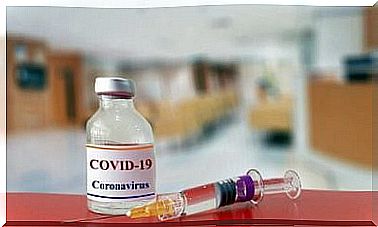Hyperinsulinemia: What Is It And What Are The Symptoms?

Insulin is an extremely important hormone for our body, as it regulates the amount of glucose in the blood and tissues so that they can perform their functions. When insulin levels in the blood are high, it is called hyperinsulinemia.
Hypoinsulinemia, or the lack of insulin in the body, typical of people with type 1 diabetes is a well-known condition. Hyperinsulinemia is not so bad as to make diagnosis difficult. For this reason, in this article we will tell you everything you need to know about it.
What is insulin?
Before defining hyperinsulinemia, we will introduce the properties of insulin. Insulin is a peptide hormone synthesized and stored by the beta cells of the pancreas.
After each meal, food is broken down into multiple substances so that it can pass through the intestines and into the blood. One of these substances is glucose, which is the essential sugar that the body uses to produce energy and perform its functions.
When glucose reaches the blood, it passes through the pancreas, activating beta cells that release stored insulin. It passes into the blood and directs glucose to the tissues for use. Insulin, therefore, is responsible for maintaining proper glucose levels.
Blood glucose or blood sugar levels
Average fasting blood glucose levels are between 70 and 110 mg / dl. When your blood sugar is too high or too low, it can cause serious health problems. Altered glucose levels are known as:
- Hyperglycemia : atypically elevated blood glucose values.
- Hypoglycemia : low blood glucose values.

What is hyperinsulinemia?
There is no precise definition of hyperinsulinemia. Typically, it is described as having more insulin in the blood than normal. The causes can be different, and we explain them below:
Insulin resistance
Insulin resistance is a condition that has experienced an increase in recent years, as the number of people with type 2 diabetes increases.
If you consume uncontrolled amounts of sugars over the years, insulin increases to direct these excesses into the tissues and keep blood levels stable. However, the body gets used to using larger amounts of insulin, which is why it will not respond to smaller amounts, effectively creating resistance.
To compensate for this resistance, the body will produce more insulin which will go into the bloodstream. There will therefore be a picture of hyperinsulinemia with hyperglycemia.
Tumors of the pancreas among the causes of hyperinsulinemia
A less common cause of hyperinsulinemia is cancers that cause increased insulin production, called insulinomas. Insulinomas are tumors that are difficult to diagnose due to their small size that does not allow them to be easily seen on imaging tests. About 10% of insulinomas are malignant.
They are tumors derived from the beta cells of the pancreas that produce and release high levels of insulin into the blood. This hyperinsulinemia causes all the glucose to be transported into the tissues and no longer remains glucose in the blood, or hypoglycemia is produced.
Hypoglycemia is a serious condition that can cause a variety of symptoms, including:
- Nervousness.
- Tremors.
- Palpitations.
- Sweating.
- Irritability.
- Hunger.
- Pallor, etc.
If the hypoglycemia is very marked, it can involve the brain, which is a great consumer of glucose par excellence, causing alterations such as:
- Headache or headache.
- Blurred vision.
- Paresthesias: tingling, usually in the extremities.
- Behavioral disturbances.
- Confusion.
- Convulsions.
- Memory loss.
- Coma and, at worst, death.
These are tumors that must necessarily be removed in order to avoid these symptoms. On top of that, insulin is a growth factor that can cause weight gain.
The insulinoma is generally localized in the pancreas, but some people have portions of the pancreas in different positions from the usual one, in which case we speak of an ectopic pancreas; this makes the diagnosis even more complex. Fortunately, insulinomas are quite rare in the population.

Exogenous insulin
Another cause of hyperinsulinemia can be linked to exogenous insulin injection. This happens in two cases:
- A diabetic patient who mistakenly injects more insulin than she should. This causes hypoglycemia, which, as we have explained, is a serious condition.
- Factual hypoglycemia : self-injection of insulin without suffering from diabetes. This could be related to the well-known Munchausen syndrome, in which a person self-medicates or injures himself to appear ill.
In both cases, we will have low blood glucose levels with high levels of insulin, where the latter is not produced by the body, but is exogenous.
Important considerations on hyperinsulinemia
Most cases of hyperinsulinemia are due to insulin resistance, which implies high blood sugar levels. The resulting hyperglycemia is extremely dangerous because it causes diabetes and various damage to the cardiovascular system. In addition to this, as already reported, insulin is a growth factor and also promotes the onset of tumors.
It is therefore essential to keep sugar levels under control and lead a healthy life. Your doctor will be able to recommend some treatments in this regard. On the other hand, if you experience symptoms of hypoglycemia, you will need to see your doctor, given the severity of this condition.









